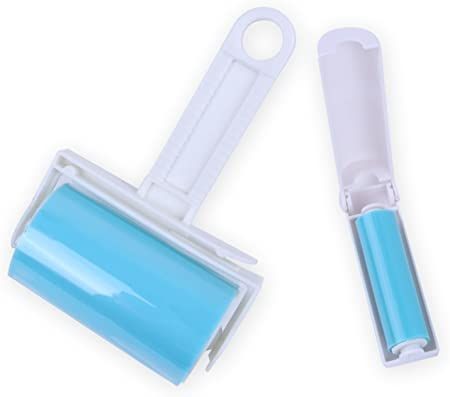As a devoted pet owner, sharing your life with furry companions brings immeasurable joy. However, it also often means sharing your wardrobe with their fur. Whether you’re a cat lover, a dog person, or adore any other furry friend, pet hair on clothes can feel like an unavoidable part of life. If you’re tired of constantly battling pet fur clinging to your favorite outfits, you’re not alone. Luckily, there are several effective and easy methods to remove pet fur from your clothes, restoring them to their fur-free glory.
Top Methods to Remove Pet Hair from Clothes
There’s no magic solution to prevent pet hair from finding its way onto your clothes, but these tried-and-true techniques will help you tackle the issue efficiently.
1. Lint Roller: The Classic Go-To
Lint rollers are a long-standing favorite for a reason. They are incredibly effective at quickly lifting pet hair, lint, and dust from fabric. Traditional lint rollers with sticky sheets are readily available and work well, but they do create disposable waste.
For a more eco-friendly approach, consider reusable lint rollers. These innovative tools work just as effectively as their disposable counterparts but can be washed and reused. After rolling it over your clothes or furniture, simply rinse the roller under water to remove the collected fur, let it dry, and it’s ready for the next use. While you might need to pause briefly to rinse and dry, the reduction in waste and the convenience of always having a lint roller ready make it a worthwhile switch.
Image: A reusable lint roller effectively removes pet hair from clothing, showcasing an eco-friendly cleaning solution.
Another variation is the lint rake. These tools feature a textured surface that effectively grabs pet hair without sticky adhesives. They are easy to use and clean, offering another reusable alternative to traditional lint rollers.
Image: A portable lint rake demonstrates its ability to efficiently remove pet hair from fabric, highlighting a simple and effective cleaning method.
For dedicated pet owners, there are lint rollers specifically designed for pet hair removal, like the ChomChom Pet Hair Remover. These often feature a built-in compartment to collect the removed hair, making disposal even easier.
Image: The ChomChom Pet Hair Remover, a specialized lint roller, efficiently collects and contains pet hair, simplifying the cleaning process.
2. Vacuum Cleaner: Deep Cleaning Power
Vacuuming isn’t just for carpets and floors; it’s also a powerful tool for removing pet hair from upholstery and, yes, even clothes. For furniture and larger fabric items, using a vacuum cleaner with an upholstery attachment can effectively lift embedded pet hair.
Especially if you own a vacuum designed for pet hair, you’ll notice a significant difference. These vacuums often come with specialized tools like motorized brush heads that are particularly effective at loosening and removing stubborn pet hair. While vacuuming works wonders on couches and bedding, it might be less practical for everyday clothing, especially delicate fabrics. However, for heavier garments like jackets or blankets, it can be a valuable method.
Image: A handheld vacuum cleaner, like the Bissell Pet Hair Eraser, effectively removes pet hair from various surfaces, demonstrating its powerful suction and specialized pet hair tools.
3. Pet Brush: Turn Grooming Tools into Cleaning Allies
Surprisingly, your pet’s grooming brush can be repurposed to remove hair from your clothes. A pet brush, designed to collect loose fur directly from your animal, can also work wonders on fabrics.
The type of brush you use will influence the results. A softer bristled brush is ideal for delicate fabrics and clothing, gently lifting hair without damaging the material. Simply lay your garment flat, hold it taut, and brush in short strokes, as if you were grooming your pet. For more robust fabrics like carpets or thick blankets, an undercoat rake can be more effective at pulling out embedded hair.
Image: A soft pet grooming brush is used to gently and effectively remove pet hair from clothing, highlighting its dual-purpose as a cleaning tool.
4. Anti-Static Spray: Repel and Release
Anti-static sprays are designed to reduce static cling, which is often what causes pet hair to stubbornly adhere to fabrics. You can purchase commercial anti-static sprays, or easily make your own homemade version.
To create a DIY anti-static spray, mix two tablespoons of fabric softener with one cup of water and a tablespoon of rubbing alcohol in a spray bottle. Shake well to combine. Lightly mist the affected clothing with the spray. The anti-static properties will help to release the pet hair, making it easier to remove with another method like vacuuming or a lint roller.
Be cautious when using fabric softener, especially in homemade sprays. Use it sparingly, as excessive amounts can be flammable and potentially stain delicate fabrics. Always test the spray on an inconspicuous area first.
5. Sticky Tape: The Quick Fix in a Pinch
When you’re in a hurry and don’t have a lint roller handy, sticky tape can be a surprisingly effective emergency solution. This simple trick involves wrapping tape around your hand with the sticky side facing outwards and dabbing or rolling it over the furry areas of your clothes.
While it might take a little more time and tape compared to a lint roller for larger areas, sticky tape is readily available and perfect for quick touch-ups before leaving the house. It’s not the most efficient method for large-scale cleaning, but it’s a reliable trick to have up your sleeve for those last-minute pet hair emergencies.
Choosing the Best Method for You
Each of these methods offers different advantages depending on the situation and the type of fabric.
- Lint rollers are the overall winner for speed, convenience, and effectiveness on most clothing items. Reusable versions offer an eco-friendly and cost-effective long-term solution.
- Vacuum cleaners provide deep cleaning power for upholstery and heavier fabrics, ideal for tackling embedded hair.
- Pet brushes offer a dual-purpose solution, utilizing grooming tools for clothing care, especially gentle on delicate fabrics.
- Anti-static sprays are best used in conjunction with other methods, preventing hair from clinging and making removal easier.
- Sticky tape is the perfect quick fix for small areas or when you’re on the go.
Prevent Pet Hair Buildup on Clothes
While removing pet hair is essential, preventing excessive buildup is even better. Regular pet grooming is key to reducing shedding. Brush your pet frequently, ideally several times a week, to remove loose fur before it ends up on your clothes and furniture.
Additionally, consider protecting furniture with throws or covers that are easily washable. Regularly washing your pet’s bedding and any fabric items they frequently come into contact with will also help minimize hair transfer to your clothes.
FAQs
Can pet hair ruin a washing machine?
Yes, pet hair can potentially cause problems in your washing machine. Pet hair tends to clump together when wet, which can clog drains, pipes, and filters. Over time, this buildup can reduce your washing machine’s efficiency and even lead to malfunctions. It’s always best to remove as much pet hair as possible from clothing before washing to protect your appliance and prevent potential fire hazards, particularly in combination washer-dryer units.
Conclusion
Dealing with pet hair on clothes is a common challenge for pet owners, but it doesn’t have to be a constant struggle. By utilizing these effective methods, from the classic lint roller to the surprising versatility of a pet brush, you can keep your wardrobe looking clean and fur-free. Experiment with these techniques to find the best solutions that fit your lifestyle and fabric types. With a little effort and the right tools, you can confidently enjoy your furry companions without constantly battling pet hair on your clothes.

